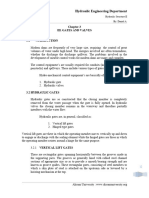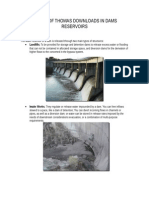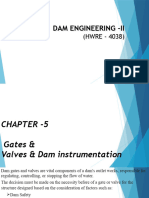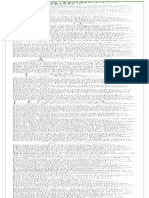Report 2
Report 2
Uploaded by
Abhishek BadwarCopyright:
Available Formats
Report 2
Report 2
Uploaded by
Abhishek BadwarOriginal Title
Copyright
Available Formats
Share this document
Did you find this document useful?
Is this content inappropriate?
Copyright:
Available Formats
Report 2
Report 2
Uploaded by
Abhishek BadwarCopyright:
Available Formats
MODEL OF RADIAL GATE OF DAMS
CHAPTER 1
INTRODUCTION
1.1. INTRODUCTION
The Radial Gate Project is a hydraulic engineering endeavor focused on the design, development,
and implementation of a radial gate system. Radial gates are commonly used in dams, barrages,
and irrigation canals to control the flow of water and regulate water levels. This report provides an
overview of the project, including its objectives, design considerations, construction, and potential
applications.
Radial gates are made for two types of installations. The first and most commonly used, is an
overflow type. This gate is designed for 1 ft of water flowing over the top of the gate when the
gate is closed. Adequate safety factors prevent damage to the gate if there is a moderate, additional
overflow beyond that limit for a short period of time. The second type employs the use of a breast
wall. This is a vertical concrete wall above the top of the gate opening that results in additional
storage capacity in front of the gate. Most radial gates are raise-to-open type, a variation is the
lower-to-open type. This requires a weir wall for mounting a seal that must make contact with the
curved face plate. Silt and debris entrapment is a problem with this arrangement.
A side view of a radial gate resembles a slice of pie with the curved part of the piece facing the
source or upper pool of water and the tip pointing toward the destination or lower pool. The curved
face or skin plate of the gate takes the form of a wedge section of cylinder. The straight sides of
the pie shape, the trunnion arms, extend back from each end of the cylinder section and meet at a
trunnion which serves as a pivot point when the gate rotates. A spillway gate is also referred to as
a stop gate. These are adjustable gates which can control the water flow of rivers, streams and
reservoirs. Therefore, they act as a type of barrier as well for storage of additional water too. They
help to pass water safely and in a controlled way around, over and through a dam when there is an
excess of water. Let review different types of spillway gates and uses.
Pravara Rural Engineering College Loni. Page 1
MODEL OF RADIAL GATE OF DAMS
The arms act as columns and transfer thrust to a common bearing located on either side of the gate
opening. Flow is underneath the curved face as the gate is opened. This design results in a light-
weight, economical gate that can be opened and closed with minimum effort and with compara-
tively small number of turns of the handwheel on the hoist There are several types of spillway
gates, each serving a specific purpose for dams.
This type of gate is positioned at the top of a dam, which increases the overall water and reservoir
captivity of the dam. With this gate, the aim is to maintain the right water levels. The gate can be
opened or closed with very little effort. As the pressure transfers from the curved face of the gate
through to the support beams and into the curved arms, which provides much better resistance.
It can be counterbalanced in any position of opening and when used as a crest gate, can be operated
directly by floats situated in chambers. In these chambers the water level and, therefore, the flood
level is determined by the differential flow principle in which comparatively small change in res-
ervoir level is followed by large alteration of water level in the chamber.
Horizontal face support beams are made from structural steel channels. These beams vary in size
with the width of the gate and maximum head of water. They also vary in quantity and spacing
with the height of the gate. Welded to the end of each channel is a heavy steel gusset with holes
punched to receive the side arms. These support beams are normally painted. They can be hot-dip
galvanized for additional corrosion protection.
Gears shall be cast iron or steel, accurately machined with cut teeth, smooth running with suitable
shafts of cold-rolled steel. The cast iron housing shall be machined to receive all shafting and shall
hold gears in alignment without binding. All gearing and shafting shall be suitable for auxiliary
motor operation. The hoist shall be furnished with cold-rolled steel drum shaft and two fabricated
drums manufactured from pipe. Each drum will have an inner and outer flange to aid in guiding
the wire rope. Stainless steel cables and clamps shall be furnished for field connection of the cables
to the bottom corners of the gate.
Pravara Rural Engineering College Loni. Page 2
MODEL OF RADIAL GATE OF DAMS
1.2. OBJECTIVE OF PROJECT
The primary objectives of the Radial Gate Project are as follows:
a. Develop a reliable and efficient radial gate system.
b. Design gates that can withstand high water pressure and varying hydraulic
loads.
c. Ensure smooth operation and precise control of water flow. d. Construct gates using durable
materials and efficient manufacturing processes.
e. Implement a maintenance plan to ensure long-term functionality.
3. Design Considerations: Several key design considerations were taken into account during the
Radial Gate Project:
a. Structural Integrity: The gates must be designed to withstand water pressure, turbulence, and
other hydraulic forces.
b. Operational Flexibility: The gates should provide precise control over water
flow, allowing for adjustments to meet varying requirements.
c. Sealing Mechanism: The gate design should incorporate an effective sealing
mechanism to minimize leakage and prevent water seepage. d. Material Selection: Durable mate-
rials with corrosion resistance properties
were chosen to ensure longevity and minimize maintenance requirements.
e. Automation: The possibility of incorporating automation and remote control features was ex-
plored to enhance operational efficiency.
Pravara Rural Engineering College Loni. Page 3
MODEL OF RADIAL GATE OF DAMS
1.3 Construction and Implementation:
The construction and implementation phase of the Radial Gate Project involved the following
steps:
a. Detailed Design: Detailed engineering drawings and specifications were
prepared based on the project requirements.
b. Fabrication: The gates were manufactured using advanced fabrication techniques, ensuring pre-
cision and quality.
c. Installation: The gates were installed at the designated locations, considering factors such as
foundation stability and hydraulic conditions.
d. Testing and Commissioning: The gates underwent rigorous testing to ensure
their functionality, operational efficiency, and structural integrity.
e. Monitoring and Maintenance: A monitoring and maintenance plan was implemented to regularly
assess the gates' performance, address any issues, and carry out preventive maintenance.
4. Construction and Implementation:
The construction and implementation phase of the Radial Gate Project involved the following
steps:
a. Detailed Design: Detailed engineering drawings and specifications were prepared based on the
project requirements.
b. Fabrication: The gates were manufactured using advanced fabrication techniques, ensuring pre-
cision and quality.
c. Installation: The gates were installed at the designated locations, considering factors such as
foundation stability and hydraulic conditions.
d. Testing and Commissioning: The gates underwent rigorous testing to ensure their functionality,
operational efficiency, and structural integrity.
Pravara Rural Engineering College Loni. Page 4
MODEL OF RADIAL GATE OF DAMS
e. Monitoring and Maintenance: A monitoring and maintenance plan was implemented to regularly
assess the gates' performance, address any issues, and carry out preventive maintenance.
Pravara Rural Engineering College Loni. Page 5
MODEL OF RADIAL GATE OF DAMS
CHAPTER 2
LITERATURE REVIEW
Radial gate are usually operated from above with a gearbox, chain, or electric motor assembly.
In designating the size of a radial gate, the width is given first then allocates the height. Height is
the vertical distance projected from the sill level to the top of the gate. The opening, which covers
in the vent between piers is the height of that gate. It is not the curved length of the gate. Sill is
generally located downstream of the spillway crest to improve flow condition and avoid cavitation
on the downstream glacis.
2.1 SKIN PLATE:
The skin plate of a radial gate is made up of skin plate bent into the shape of an arc. Thrust of
water is taken by the convex face of gate. The radius of curvature of gate is generally H to
1.25H, where H is the vertical distance between the sill and the top of gate. A 1.5 mm corrosion
allowance is provided while deciding the thickness. The skin plate assembly is fabricated in
segments so that they are conveniently transported and assembled at site. The skin plate is
provided with either vertical or horizontal stiffeners.
2.2 HORIZONTAL GIRDERS:
Horizontal girders are provided to take up the water thrust from the skin plate. Horizontal
girders are generally plate girders, which has webs, web stiffeners and flanges. Drain holes
are provided to prevent the water collection, which causes rusting.
2.3 RADIAL ARMS
Radial arms start from the trunnion hub and are connected to the vertical end supports of skin
plate. In case of small size gates connected to horizontal girders. There are two types of arm as-
semblies such as Parallel arms and inclined arms.
Pravara Rural Engineering College Loni. Page 6
MODEL OF RADIAL GATE OF DAMS
2.4 TRUNNION ASSEMBLY
Trunnion assembly consists of trunnion hub connected to the arms, trunnion pin acting as a hinge,
and trunnion bracket mounted on anchor girders. If the gate is designed with inclined arms, side
thrust due to inclined arms could be tackled by suitable anchorage such as by providing the tie
girder between two trunnions of a gate. Trunnion hub is a complicated and heavy steel casting.
The castings of trunnion assembly are to be thoroughly checked for soundness. blow holes and
cracks should be avoided. Generally, phosphor bronze bearing metal bushing is fitted to trunnion
hub. Generally, Trunnion pins are of cast steel or forged carbon steel with hard chrome or nickel
plating to reduce rusting, friction and wear.
2.5 ANCHORAGE SYSTEM
The trunnion rests on an anchor girder, which is held on the concrete of the spillway pears by the
set of tie flats. The total water thrust exerted on the gate is transmitted to the piers as bond stress
between tie flats and
Pravara Rural Engineering College Loni. Page 7
MODEL OF RADIAL GATE OF DAMS
CHAPTER 3
SCOPE OF THE PROJECT
3.1. APPLICATIONS:
The Radial Gate Project's radial gate system has various potential applications, including:
a) Dams and Reservoirs: Radial gates can be utilized to regulate water levels and control the
release of water from reservoirs.
b) Irrigation Systems: Radial gates can manage water distribution in irrigation canals, ensur-
ing efficient water usage for agriculture.
c) Flood Control: Radial gates can be employed in flood control systems to divert or regulate
excess water during heavy rainfall or flooding.
d) Water Treatment Facilities: Radial gates can assist in controlling water flow and pressure
in water treatment plants.
e) Hydroelectric Power Generation: Radial gates are crucial components in hydroelectric
power plants, regulating water flow to optimize electricity generation.
f) Flood Control Systems: Radial gates play a crucial role in flood control systems by ena-
bling the management of water levels in rivers, canals, and other waterways. They can be
used to divert excess water away from vulnerable areas, preventing or minimizing the im-
pact of flooding.
g) Navigation Locks: Radial gates are utilized in navigation locks, which are structures that
allow boats and ships to traverse waterways with varying water levels. They can be oper-
ated to raise or lower the water level in the lock chamber, enabling vessels to navigate
through the lock.
h) Fish Ladders: Radial gates are sometimes incorporated into fish ladders or fishways, which
are structures designed to help migrating fish bypass barriers such as dams or weirs. The
gates can be adjusted to create suitable water conditions that facilitate fish passage
Pravara Rural Engineering College Loni. Page 8
MODEL OF RADIAL GATE OF DAMS
CHAPTER 4
PROJECT INFORMATION
4.1 . GENERAL:
Gates, hoist, and accessories shall be of the size, material, and construction shown
on the manufacturer's drawings and specified herein. They shall be Hydro Gate®
overflow-type or breast wall-type radial gates or approved equal. Similar installa-
tions shall have operated successfully for ten years or more. All component parts
shall be of the type material shown in the "Materials" section of the specification.
An installation list showing five similar projects will be required.
4.2 . DESIGN:
Overflow-type gates shall be designed to withstand a water depth of 1' greater than
the vertical height of the gate. The breast wall-type gate shall be designed to with-
stand a water depth of 10 ft on the invert. Maximum face deflection shall be 1/360
of the width. Design loads placed on the structural reinforcing channels shall not
induce stresses in excess of those specified in Section 1.5.1.4 of AISC specification
for structural steel building. The slenderness ratio of the radial arms shall not ex-
ceed 200. The curved face plate shall be 1/4" minimum.
4.3 . GATE FACE ASSEMBLY DRAWING:
The face assembly shall consist of horizontal structural members and a curved face
plate. Horizontal structural members shall be of adequate size and correctly located
to transmit the thrust from the face of the gate to the radial arms. The steel face
plate shall be attached to the structures by welding. Sufficient holes shall be located
around the perimeter of the assembly for attaching the seals. The side seals and the
top seal for breast wall-type gates shall be flat rubber held in place by steel retainer.
The bottom seal shall be rubber of the hollow J-seal type.
Pravara Rural Engineering College Loni. Page 9
MODEL OF RADIAL GATE OF DAMS
4.4 . RADIAL ARMS:
The radial arm assemblies shall consist of structural angles welded to a pin plate
and punched to match gusset plates welded to the horizontal structural members of
the face assembly. Bolts for field assembly shall be provided. The steel pin plate
shall transmit the load from the radial arms to the pivot pin. A steel collar shall be
welded to the pin plate to distribute the bearing load on the pin. It shall be match
drilled with the pin.
4.5 . PINS AND PIN BEARINGS
The cold-rolled steel pivot pins shall be sized to transmit the load to the pin bear-
ings. They shall be bolted to the pin plate collar for field assembly. The cast iron
pin bearings shall extend into the concrete and have sufficient surface to properly
distribute the full load to the structure. The bearing shall be bored full length for a
running fit with the pivot pin.
4.6 . WELDING
Manual welding operators performing welding operations on these gates or acces-
sories shall be qualified either under Section 9, Part A, of the ASME Boiler and
Pressure Vessel Code, or under the Standard Qualification Procedure of the Amer-
ican Welding Society. All welds shall have complete fusion with the base metal
and shall be free from cracks, oxides, slag inclusions and gas pockets.
Pravara Rural Engineering College Loni. Page 10
MODEL OF RADIAL GATE OF DAMS
CHAPTER 5
METHEDOLOGY
5.1 . RADIAL ARMS AND PIN PLATE:
Radial arms are fabricated from structural steel angles, with larger and thicker angles being
used as the gate height increases. Each angle acts as a column in transmitting the load from
the face support channel to the pin plate. The forward or upstream end of each angle is
punched with holes to match those in the gusset plate. The back end of each angle termi-
nates at a common pin plate in a fan-like arrangement. This steel pin plate is made thicker
as the gate height, width, and head increase. A steel collar is welded to the pin plate to form
a hub to receive the pin. The hub and pin are cross drilled to hold the gate pin in position.
The pin is removable to facilitate installation of the gate. The entire assembly is painted,
or it can be hot-dip galvanized along with the face support beams.
5.2 . BEARING AND PIN ASSEMBLY DRAWING:
Pin bearings are a heavy cast iron or fabricated housing and are bored to receive the pin.
Bearings are supplied with "fins" to firmly anchor them and distribute the total thrust to the
concrete. Pin bearings may be aligned and supported in the forms and concrete poured
around them, or a recess can be formed at the proper location in the side walls and the
bearings can be grouted in place after the gate is installed. Fabricated brackets to hold the
pin bearing can also be mounted to the surface of the channel walls. Removable cold-rolled
steel pins of the proper diameter are supplied to transmit the thrust on the gate to the pin
bearings. The pin bearing is located high and downstream out of the water and requires no
lubrication.
5.3 . SEALS:
a. SIDE SEALS: Side seals on both the overflow and breast wall gates are made from
neoprene. The standard side seal is a J-seal bolted to the edge of the face plate and
Pravara Rural Engineering College Loni. Page 11
MODEL OF RADIAL GATE OF DAMS
is held in place by a steel retainer bar. The side seal is adjusted to compress against
the side rubbing plate to form a watertight seal.
b. BOTTOM SEAL: The bottom seal is also a J-seal that is attached to the gate by
bolting. As the gate closes, its weight causes a slight deflection in the seal as it
contacts the invert of the opening. This flexibility allows the bottom seal to com-
pensate for slight irregularities in the concrete floor. However, if the floor is out of
level by more than 1/8", the seal will not compensate for this much difference and
excessive leakage will result. To minimize this possible discrepancy in construc-
tion, an adjustable sill as described in this section is recommended.
c. TOP SEAL: The top seal on a breast wall-type radial gate is made by attaching a
flat section of rubber to the underneath side of the breast wall. An angle attached
along the top front face of the gate projects toward the breast wall and forms the
other portion of the seal. As the gate is closed, the protruding leg on the angle makes
contact with the rubber projecting from the breast wall and seals the space along
the top of the opening. The hoist ropes pass through a slit in the seal, allowing some
leakage.
5.4 . MOTOR OPERATION:
Hydro Gate hoists can be motorized using an electric valve actuator attached to the top of
the hoist to drive its vertical input shaft. The unit also includes an electric motor; reversing
controller; push-button stations for raise, stop and lower; two indicating lights; geared limit
switches; torque switches; and handwheel for emergency operation.
5.5 . AUTOMATIC OPERATION:
A hoist with an electrically operated lift mechanism can be equipped for automatic opera-
tion of the radial gate by use of logic controls to control flow and level, or to interface with
other process controls.
Pravara Rural Engineering College Loni. Page 12
MODEL OF RADIAL GATE OF DAMS
CHAPTER 6
CONCLUSION
CONCLUSION:
The Radial Gate Project successfully designed, developed, and implemented a reliable and effi-
cient radial gate system. The project addressed key design considerations and achieved the objec-
tives of structural integrity, operational flexibility, and precise control of water flow. The con-
structed gates have potential applications in various hydraulic engineering projects, including
dams, irrigation systems, flood control, water treatment facilities, and hydroelectric power gener-
ation. Continued monitoring and maintenance will be necessary to ensure the long-term perfor-
mance and functionality of the radial gate system
Pravara Rural Engineering College Loni. Page 13
MODEL OF RADIAL GATE OF DAMS
CHAPTER 7
PHOTO GALLERY
Pravara Rural Engineering College Loni. Page 14
MODEL OF RADIAL GATE OF DAMS
Pravara Rural Engineering College Loni. Page 15
MODEL OF RADIAL GATE OF DAMS
Pravara Rural Engineering College Loni. Page 16
MODEL OF RADIAL GATE OF DAMS
Pravara Rural Engineering College Loni. Page 17
MODEL OF RADIAL GATE OF DAMS
Pravara Rural Engineering College Loni. Page 18
You might also like
- HDPE Pipeline Installation and DesignDocument13 pagesHDPE Pipeline Installation and DesignYoungtae Kim100% (5)
- Design and Estimation of Dry Dock PDFDocument78 pagesDesign and Estimation of Dry Dock PDFsathi1118950% (2)
- Small Concrete Dams PDFDocument48 pagesSmall Concrete Dams PDFjoaoaugusto7950% (2)
- Coiled Tubing Operations at a Glance: What Do You Know About Coiled Tubing Operations!From EverandCoiled Tubing Operations at a Glance: What Do You Know About Coiled Tubing Operations!Rating: 5 out of 5 stars5/5 (2)
- Temple Tank AlgaeDocument56 pagesTemple Tank AlgaeGopalakrishnan MohanNo ratings yet
- Vetical Dam Hoist MechanismDocument38 pagesVetical Dam Hoist Mechanismkrishnan_selvaNo ratings yet
- HS 3 6Document23 pagesHS 3 6asimamawNo ratings yet
- Water Resources EngineeringDocument29 pagesWater Resources EngineeringJochelle TumambingNo ratings yet
- Natnael AkliluDocument17 pagesNatnael Aklilunatiz addisNo ratings yet
- Spillway Gate RelibilityDocument5 pagesSpillway Gate RelibilityDheeraj ThakurNo ratings yet
- Week 13 Lecture 2 (Gates Valves)Document45 pagesWeek 13 Lecture 2 (Gates Valves)s11197376No ratings yet
- Chapter-3 Gates and ValvesDocument12 pagesChapter-3 Gates and ValveszelalemniguseNo ratings yet
- Hydraulic Means Operated, Moved, or Effected by The Means of Water. ... The PurposeDocument8 pagesHydraulic Means Operated, Moved, or Effected by The Means of Water. ... The Purposesirajt300No ratings yet
- Works of Thomas Downloads in Dams Reservoirs-InglesDocument33 pagesWorks of Thomas Downloads in Dams Reservoirs-InglesÁnikka Quevedo GarcíaNo ratings yet
- GatesDocument49 pagesGatesPrem Singh RawatNo ratings yet
- 418 DESIGN of GIBE III DAM MIDDLE LEVEL OUTLETS Cagiano Pietrangeli Pianigiani 2017Document9 pages418 DESIGN of GIBE III DAM MIDDLE LEVEL OUTLETS Cagiano Pietrangeli Pianigiani 2017sentapa89No ratings yet
- Ch-1 Spillways-1Document6 pagesCh-1 Spillways-1Fikir YoNo ratings yet
- Chapter - 5 Dgates and Dam SafteyDocument15 pagesChapter - 5 Dgates and Dam SafteyKaseye AmareNo ratings yet
- Water GatesDocument11 pagesWater GatesEhlma LacuarenNo ratings yet
- Design of Radial Gate Using Rectangular 2Document55 pagesDesign of Radial Gate Using Rectangular 2Dangol Rupesh100% (1)
- Design Aspects of Gates of DamDocument6 pagesDesign Aspects of Gates of DamdheeruNo ratings yet
- Culvert and Bridge Material - 1 and 2Document116 pagesCulvert and Bridge Material - 1 and 2Tulu SenaNo ratings yet
- E2 15 04 10Document6 pagesE2 15 04 10Evelyn Deza GuzmánNo ratings yet
- Gates and ValvesDocument9 pagesGates and ValveshailishNo ratings yet
- Design of Hydraulic WorksDocument22 pagesDesign of Hydraulic WorksMariano Jesús Santa María CarlosNo ratings yet
- Enlarged Cotter Dam Diversion Gate Design - The Challenge and The TestDocument6 pagesEnlarged Cotter Dam Diversion Gate Design - The Challenge and The Testadelmo1175No ratings yet
- 10.2 Erection & Maintenance of Gates & HoistsDocument22 pages10.2 Erection & Maintenance of Gates & Hoistsharry100% (1)
- Hydro Mechanical Design PDFDocument126 pagesHydro Mechanical Design PDFPitamber BhusalNo ratings yet
- Design of Hydraulic WorksDocument23 pagesDesign of Hydraulic WorksHowell Danner Peña Chaquila100% (1)
- 2E-1 ManualDocument12 pages2E-1 ManualAntonio PérezNo ratings yet
- CH - 5 Bottom Outlets (Compatibility Mode)Document63 pagesCH - 5 Bottom Outlets (Compatibility Mode)zelalemniguseNo ratings yet
- Components of DamsDocument37 pagesComponents of DamsAmanuel AzemeteNo ratings yet
- Cross Drainage: Topic 821 - GeneralDocument13 pagesCross Drainage: Topic 821 - GeneralBlessed ZiyambeNo ratings yet
- Hydraulic Structures Ch3 - BizunehDocument115 pagesHydraulic Structures Ch3 - BizunehAshraf Bestawy73% (11)
- 2N-1 General Information For Design of Culverts: Iowa Stormwater Management ManualDocument30 pages2N-1 General Information For Design of Culverts: Iowa Stormwater Management Manualhaniscd1536No ratings yet
- NSM Exp - 7 (Final)Document12 pagesNSM Exp - 7 (Final)VAISHNAVI KNo ratings yet
- Chapter 18 - CulvertDocument40 pagesChapter 18 - CulvertJohnyReubenNo ratings yet
- Decision Support System For Selecting Type of Moveable Dam Gate To Handle Tidal Flood Issued (A Case Study in The Parid River, Cilacap, Indonesia)Document11 pagesDecision Support System For Selecting Type of Moveable Dam Gate To Handle Tidal Flood Issued (A Case Study in The Parid River, Cilacap, Indonesia)irfani_mtNo ratings yet
- HDPE Pipeline Installation and DesignDocument19 pagesHDPE Pipeline Installation and Designcrys suryo prayogo100% (1)
- Gravity Fed SchemesDocument8 pagesGravity Fed SchemesAnita0% (1)
- Mini Project BrigeDocument6 pagesMini Project BrigeShakti prasad Guru100% (2)
- Lecture 2 Water Distribution SystemsDocument15 pagesLecture 2 Water Distribution SystemsAbu Al RubNo ratings yet
- Oliveros, Kyle Gio M. Bspe 5B PTQ Riser SystemsDocument14 pagesOliveros, Kyle Gio M. Bspe 5B PTQ Riser Systemsglenn vincent floresNo ratings yet
- Gates For Flow ControlDocument41 pagesGates For Flow ControlkyogesswaranNo ratings yet
- Trench DrainsDocument1 pageTrench DrainsAbhi LashNo ratings yet
- Diversion and HeadworkDocument81 pagesDiversion and HeadworkFiraol OromoNo ratings yet
- Guidelines For Design of SpillwayDocument8 pagesGuidelines For Design of Spillwayrvkumar3619690No ratings yet
- Hydraulic Structures For Flow Diversion and StorageDocument25 pagesHydraulic Structures For Flow Diversion and StorageEndless LoveNo ratings yet
- Lecturenote - 1762908453dam Eng II - Docx AllDocument57 pagesLecturenote - 1762908453dam Eng II - Docx AllAliyyi JamaalNo ratings yet
- Wa0025. 1Document18 pagesWa0025. 1Chaitanya KumbharNo ratings yet
- Short Notes on Hydraulic StructuresDocument4 pagesShort Notes on Hydraulic Structuresbereket gNo ratings yet
- Introduction-to-Hydraulic-Design-of-CulvertsDocument10 pagesIntroduction-to-Hydraulic-Design-of-CulvertsHalo KhalidNo ratings yet
- EM 1110-2-1602 Part 2Document10 pagesEM 1110-2-1602 Part 2Hazrat YounusNo ratings yet
- Structural Design Considerations: EM 1110-2-2200 30 Jun 95Document4 pagesStructural Design Considerations: EM 1110-2-2200 30 Jun 95Noble Obeng-AnkamahNo ratings yet
- Iowa Storm Water Management Manual: Design Standards Chapter 14-Design of CulvertsDocument31 pagesIowa Storm Water Management Manual: Design Standards Chapter 14-Design of CulvertsKok WaiNo ratings yet
- Hydraulic Structures II Lecture NoteDocument197 pagesHydraulic Structures II Lecture NoteAbebaw100% (2)
- Rabigh WTP & Dam ReportDocument16 pagesRabigh WTP & Dam ReportShehroz Ahmad ShoaibNo ratings yet
- Chapter 6 Dam and Spillways2Document48 pagesChapter 6 Dam and Spillways2Hasnolhadi Samsudin100% (1)
- Sewage Disposal Works: Their Design and ConstructionFrom EverandSewage Disposal Works: Their Design and ConstructionNo ratings yet
- Irrigation Works: The Principles on Which Their Design and Working Should Be Based, with Special Details Relating to Indian Canals and Some Proposed ImprovementsFrom EverandIrrigation Works: The Principles on Which Their Design and Working Should Be Based, with Special Details Relating to Indian Canals and Some Proposed ImprovementsNo ratings yet
- Building Landmarks - Bridges, Tunnels and Buildings - Architecture and Design | Children's Engineering BooksFrom EverandBuilding Landmarks - Bridges, Tunnels and Buildings - Architecture and Design | Children's Engineering BooksNo ratings yet
- Allowable Overtopping of Earthen DamsDocument10 pagesAllowable Overtopping of Earthen Damskskim4No ratings yet
- Adama Town Water Supply ProjectDocument145 pagesAdama Town Water Supply ProjectZed Phil IndNo ratings yet
- Gravity Dams: Design, Galleries and Joints - Irrigation - AgricultureDocument1 pageGravity Dams: Design, Galleries and Joints - Irrigation - AgricultureAkshay ThakurNo ratings yet
- Cu 152030 UsersDocument18 pagesCu 152030 UsersrodrurenNo ratings yet
- Risk Analysis For Cascade ReservoirsDocument14 pagesRisk Analysis For Cascade ReservoirsIsabela BalanNo ratings yet
- 3.MScWSDSE CourseDocument242 pages3.MScWSDSE CourseHawi EtanaNo ratings yet
- Website Online Barbra Bere Resume 2016Document2 pagesWebsite Online Barbra Bere Resume 2016api-313697092No ratings yet
- Dams Reservoirs-A - Alison QuartermanDocument27 pagesDams Reservoirs-A - Alison QuartermanEng-Ali Hasan Al-homamNo ratings yet
- Evacuation of Sediments From ReservoirsDocument280 pagesEvacuation of Sediments From ReservoirsBar AvaitNo ratings yet
- Rupsiabagr-Khasiyabara - EIADocument257 pagesRupsiabagr-Khasiyabara - EIAamitishaNo ratings yet
- Integrated Irrigation Sector Project (Loans 1017 & 1018-InO (SF) )Document82 pagesIntegrated Irrigation Sector Project (Loans 1017 & 1018-InO (SF) )Independent Evaluation at Asian Development BankNo ratings yet
- Ce Wre 50 MCQDocument96 pagesCe Wre 50 MCQsurendranath jadhav100% (1)
- Dambreakanalysis AreviewDocument14 pagesDambreakanalysis AreviewAnis PabiNo ratings yet
- Nestmann StelzerDocument5 pagesNestmann StelzerDarius KingNo ratings yet
- T8supple2 24 PDFDocument13 pagesT8supple2 24 PDFVenkataraju BadanapuriNo ratings yet
- Circuit Court Complaint - FinalDocument38 pagesCircuit Court Complaint - FinalDave BondyNo ratings yet
- Situation 1. Oil at Specific Gravity 0.761 Flows From Tank A To Tank E, As ShownDocument2 pagesSituation 1. Oil at Specific Gravity 0.761 Flows From Tank A To Tank E, As ShownAgerico FunelasNo ratings yet
- Planning of Water Storage Reservoirs SarahDocument31 pagesPlanning of Water Storage Reservoirs SarahSarah Mae Gonzales100% (1)
- Urban Flood Management en HighDocument303 pagesUrban Flood Management en HighCIO-CIO100% (1)
- December KGS ReportDocument38 pagesDecember KGS ReportTessa VanderhartNo ratings yet
- Dico Eng-FrDocument126 pagesDico Eng-Frbarouniamine0% (1)
- D29 Sawunyama Thesis Small Dam PDFDocument78 pagesD29 Sawunyama Thesis Small Dam PDFShirley MunozNo ratings yet
- Sources of Drinking Water On EarthDocument28 pagesSources of Drinking Water On EarthHans John D'cruz100% (1)
- Unit I Wss Population Forecasting Intake Structure by R BhagatDocument82 pagesUnit I Wss Population Forecasting Intake Structure by R BhagatsonaliNo ratings yet
- Palamoor Ranga Reddy Lift Scheme-Penta ReddyDocument3 pagesPalamoor Ranga Reddy Lift Scheme-Penta Reddyraj100% (1)
- The Thousand Year Flood, Poland 1997Document10 pagesThe Thousand Year Flood, Poland 1997Chris AdamczykNo ratings yet
- Riko DN10003 PN10 SZ40 22mayDocument5 pagesRiko DN10003 PN10 SZ40 22maystiven villanuevaNo ratings yet
- Influences of Hydraulic Uplift Pressures On Stability of Gravity DamDocument15 pagesInfluences of Hydraulic Uplift Pressures On Stability of Gravity DamLuriezaRicablancaLuspoNo ratings yet
- 9 Philippines 4Document23 pages9 Philippines 4Dodong JojoNo ratings yet

























































































